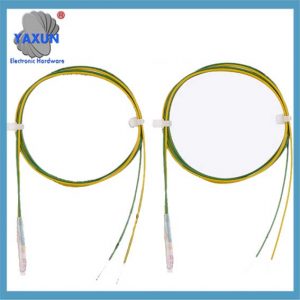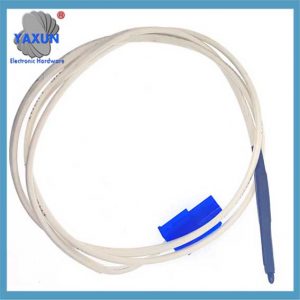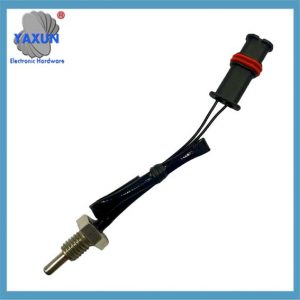NTC (ujemny współczynnik temperaturowy) thermistor sensors are used in car batteries to monitor temperature and ensure safe operation: Charging, Discharging, Bezpieczeństwo.
With the widespread application of new energy electric vehicles, the capacity, safety, health status and endurance of batteries have become the focus of attention. The battery management system is a system that monitors and controls the battery. In addition to the battery, the most core component of new energy vehicles is the battery management system (BMS). The battery management system (BMS) is mainly to improve the utilization rate of the battery and prevent the battery from being overcharged and over-discharged. Monitor the battery status and extend the battery life.
The temperature detection sensor of the battery body is installed in the gap between the batteries. It has high breakdown voltage, good weather resistance, small size and strong moisture resistance.
Temperature sensor for new energy vehicle battery
Temperature has a great impact on the performance of the car BMS battery. Obecnie, only the surface temperature of the battery is generally measured. The NTC temperature sensor is used to measure the surface temperature of the battery. It is attached to the surface of the car battery to measure the temperature. The appearance structure of the NTC temperature sensor used in the car is generally divided into several types:
1. Metal fixed ring temperature sensing probe
(1) Copper-nickel-plated material: 0.8mm metal thickness, high melting point, high hardness, and bright surface.
(2) Copper-tin-plated material: 0.8mm metal thickness, but the melting point is not high enough, the hardness is not high, and the surface is not as bright as copper-plated nickel.
(3) Stainless steel: 0.5-0.7mm thickness, to prevent rust.
(4) Pure nickel terminal: 0.2-0.3mm thickness, high hardness, easy welding, light and thin.
2. The water drop temperature sensor is encapsulated with epoxy resin
The temperature sensor encapsulated with epoxy resin is generally glued directly to the battery surface with glue. Dlatego, the temperature measurement effect may be worse than that of the metal fixing ring, and the stability is not high. Ogólnie, this head encapsulation is not used to measure the battery temperature on high-end cars.
Since it is used to monitor the temperature on the car battery, the ambient temperature near the battery will definitely be humid, so the temperature sensor must have waterproof performance. Whether it is a metal fixing ring or a water drop head encapsulation, it is encapsulated with a single-ended glass thermistor, which has a good waterproof effect.
Dlatego, the BMS battery management system is of great significance to the protection of electric vehicles and charging station equipment, and temperature is also very important for the protection of the BMS battery management system.
NTC thermistor is a common temperature component, which is very sensitive to temperature. Dlatego, in equipment that needs to monitor temperature, NTC thermistor is usually used as NTC temperature sensing devices for temperature sampling.
Charging
NTC thermistors measure the temperature of the battery during charging to ensure it’s within the recommended range. This helps to prevent charging at temperatures that are too high or too low, which can damage the battery and reduce its lifespan.
Discharging
NTC thermistors also help to measure the remaining charge in the battery by performing temperature compensation for voltage measurements.
Bezpieczeństwo
NTC thermistors can detect temperature changes and react quickly to protect the battery pack. They can also help to prevent peak operating loads and ensure reliable temperature monitoring in connector systems.
When to Use NTC Thermistor Probes and Why It’s Necessary …
NTC thermistors are resistors that have a negative temperature coefficient, meaning their resistance decreases as the temperature increases. They are designed to be reliable, precise, and have short response times.
 English
English العربية
العربية Български
Български 粤语
粤语 中文(简体)
中文(简体) 中文(漢字)
中文(漢字) Nederlands
Nederlands Suomi
Suomi Français
Français Deutsch
Deutsch Ελληνικά
Ελληνικά Magyar
Magyar Italiano
Italiano 日本語
日本語 한국어
한국어 Polski
Polski Português
Português Română
Română Русский
Русский Slovenščina
Slovenščina Español
Español Svenska
Svenska ภาษาไทย
ภาษาไทย Türkçe
Türkçe Tiếng Việt
Tiếng Việt



